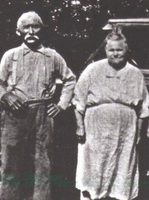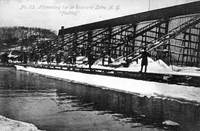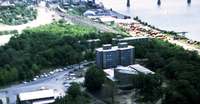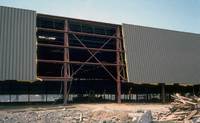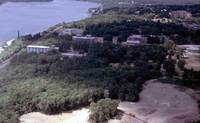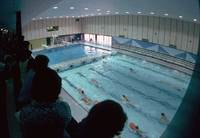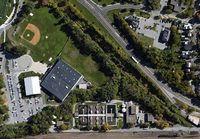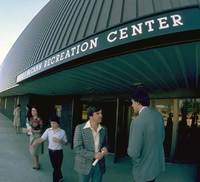Myers Property
The Myers parcel refers to the Marist College campus section south of the Bech parcel. It houses the McCann Athletic Center (see note 1). It was purchased by Henry Duane Myers in 1857 and by Marist College in 1963 (see note 2).
The Myers parcel is less interesting in terms of who owned the land than for touching on several forgotten industries. It stood at the northern end of the industrial zone along the river which supported numerous industries. Edward Bech operated two iron foundries, but there were many other industries forgotten in the history of the city and town of Poughkeepsie.
Poughkeepsie Silk Company
The Poughkeepsie Silk Company was one of the first industrial projects sponsored by the Improvement Party (see note 3). The company imported silk from China and wove it into various articles. It was incorporated in 1835 with its chief building along the Hudson River. The building was long a center of manufacturing for a variety of trades. The company even attempted to cultivate silkworms, growing a tract of mulberry trees at the intersection of Delafield Street and Post Road (the latter now called Washington Street.)
Poughkeepsie Locomotive Company
In 1837 the Silk Company sold a parcel to Henry F Talmadge who was acting as an agent for the Poughkeepsie Locomotive Engine Company (see note 4). The parcel was along the river, just north of the Whaling Dock and north of the present Hoffman Street. In 1839 it sold an even larger parcel, again through Henry F Talmadge (see note 5). The Locomotive Company was started after the panic of 1837. The company built a brick building and was capable of producing between seventy-five and one hundred locomotives and tenders annually. Timing is important. The railroad from either Albany or New York City had not reached Poughkeepsie until 1848. Henry D Myers in an 1884 interview stated the engine company produced only one locomotive which ran on the Long Island Railroad for years. It must have been shipped there by boat (see note 6). The locomotive company land and assets were purchased by Francis Griffin in a bankruptcy action in 1844 (see note 7).
Henry Duane Myers (1816 – 1887)
The sale Charles C North to Henry D Myers shifted transactions from speculation to usage (see note 8). Henry was a surveyor (see note 9). From his knowledge of the earlier deeds and general topography of the area, he negotiated access rights to his dock along the Hudson River as well as water rights extending into the Hudson (see note 10).
The deed of sale to Myers as well as several deeds of sale to Elizabeth McCarty Bech relating to the land directly north of the Myers parcel all mention a brickyard, but it is not clear whether the brickyard was on the Myers lot or any of the Bech lots. Many of the industrial buildings along the Poughkeepsie waterfront were built with brick, and the Hudson shoreline is dotted with many long forgotten brickyards. It is likely that the brickyard cited here used the nearby clay deposits as raw material, and may have gone out of business when the useful clay supply was exhausted. It is consistent with the discovery by Marist College officials in 1960 that the soil under the current McCann Baseball field would be unsuitable to support the three dormitories planned, all of which were to use the footprint of the Sheahan Dormitory (see note 11).
Ice harvesting and storage
Henry D Myers built an ice storage plant on the dock and for twenty five years operated the ice business. In an era before electricity, ice was usually harvested from lakes or from the Hudson River for sale to the cities along the river, especially New York City. The Hudson River is an estuary so that salt wateris present in the Hudson to about Chelsea between Beacon and Poughkeepsie. Myer’s position made it possible to harvest fresh water ice from the Hudson and ship the ice by boat or by railroad the cities lower down the river. He secured the rights to the water near his land so that he might use it for his ice making.
Ice harvesting was not the only trade for Henry D Myers. For forty five years he operated a grocery store along 253 and 255 and 257 Main Street in Poughkeepsie. But his census records describe him as a surveyor. The news article concerning his death stated “For many years he has been employed as a surveyor in and about this city, and we presume more property lines have been run and marked out by him than by any other man here" (see note 12). Henry dropped dead of a heart attack in 1887 while supervising the harvesting of ice.
In his will, Henry D Myers left the store along Main Street and the Myers dock to his two children Hiram W. Myers and Susan Myers Olivet. His will made specific provision for his wife which provisions were intended to replace her dower rights. This led to a legal technicality, since a husband might not change his wife’s dower rights. When the time came to sell the property in 1892, Henry’s widow registered her approval of the arrangement spelled out in Myer’s will (see note 13). With this technicality out of the way, Hiram and Susan sold the parcel to Albert Edward Tower and his brother Joseph Tuckerman Tower (see note 14).
Albert Edward Tower and Joseph Tuckerman
Albert Edward Tower, their father, had been partner with Edward Bech in the iron business. Albert died 24 December 1891, leaving control of the Fallkill Iron Works to his two sons. The brothers held on to the Myers parcel for seventeen years for reasons unknown. It is unlikely that either brother wanted it for his residence, so a better guess is that they foresaw possibility of northern expansion. Unfortunately this was an era of the twilight of local foundries, as the discovery of huge iron deposits in the Mesabi Range in Minnesota and availability of coal in Pennsylvania spurred the growth of Pittsburgh as the dominant center for the manufacture iron and steel.
By 1913 the Poughkeepsie Iron Works ceased operations, and sales were conducted to dispose of the land. The Myers dock between the railroad tracks and the Hudson was sold to Arthur Dutton of Springfield MA, who developed the largest lumber yard on the East Coast. His company acted as a wholesaler to smaller lumber companies.
Giant Portland Cement Company
The Towers brothers (and their wives) sold the Myers property to Allison Butts, a lawyer in Poughkeepsie for $25,000. After Allison butts died his widow sold the parcel to William A Redding. Two years later Redding sold the parcel to Vindex Land Co, a real estate developer operating out of New York City. Vindex was seeking deposits of limestone and had located about ten spots near Poughkeepsie, several along the route of the Poughkeepsie & Eastern RR (see note 15). Vindex sold the collection of sites, including the Myers parcel to Giant Portland Cement Company (see note 16). There was no valuable limestone on the Myers parcel, but Giant Portland was obliged to purchase it as part of the deal, it quickly sold it to the New York Central Railroad Company (see note 17).
New York Central Railroad
In 1963 I was alerted to the possibility of acquiring the parcel as the New York Central was attempting to dispose of any extra land for which it had no use. This would relieve the New York Central of tax liabilities. I traveled to the headquarters in New York City. During the course of the negotiations, the agent told me that at one time the railroad had thought of using the gently sloping land as a humping station (see note 18 ). When the railroad abandoned this plan, the land became available.
Although Marist College had no precise plan for use of the Myers parcel, it made sense to acquire the land for future development if the price was right. We settled on the purchase of 10.4 acres (down from 15.7 because the land between the railroad tracks had been sold to Arthur Dutton) for $7,000 but with two additional conditions. There were two pedestrian bridges built by the railroad as part of the agreement with the Marist Brothers in 1912. The College agreed to the removal of the northern bridge which had been planned for use by the juniors on the property north of the Water Works Road to swim in the Hudson River. That custom ceased with the construction of the outdoor pool to replace the lake just north of the Water Works Road. The other pedestrian bridge planned for the Novitiate and Scholasticate was near the Sheahan, Leo and Champagnat dormitories and would provide access to the Martin Boathouse constructed in 1963. The railroad agreed to leave the bridge in place but the College agreed to maintain the bridge.
Leveling the field 1963 to 1976
The Myers parcel sloped quickly down to the level of the New York Central Railroad. In 1963 the state began construction of an arterial highway to reduce congestion through the city of Poughkeepsie. This became the new route Nine, which had fought its way through the business center of the city.
One problem facing the contractor was the requirement to remove the remains of an abandoned dump near the northern end of the proposed route (see note 19). Jack Gartland, a key advisor to the President, told me that he had contacted several old-timers about the dump and they were certain that no very objectionable materials, such as abandoned autos, were in the dump. The College agreed to accept the fill from this dump provided that it received all fill for the length of the project. Gartland warned that the College ought to send representatives at unannounced times to be sure that the general contractor was not selling the good fill elsewhere.
The contractor reduced his costs for transporting the fill by obtaining permission to cross the tracks of the former Poughkeepsie & Eastern RR with his heavy earth moving equipment rather than reloading into trucks and then using public highway to access the college grounds.
Two years earlier (1961) the college abandoned its plan to locate three dormitories using the plans for Sheahan on the southern part of the Bech parcel which is now the McCann Baseball field because the footings would not be stable enough for construction of three story buildings. But the fill sent in by the arterial road contractor was excellent fill and was used to raise the level of the Myers parcel. One negative was that the Brothers Cemetery was now fifteen feet below eventual level. When the College developed plans to locate the McCann Athletic Center on the Myers parcel, it had available level land available for construction (see note 20).
The portion of the parcel that eventually wound up in Marist College possession was in the northern tip, and saw little development. The topography was not like a visitor views today. It sloped downwards at approximately the present day grading of the tracks placed by the Poughkeepsie & Eastern Railroad and was of little commercial value to Griffin, Tallman or North. They were land speculators.
Sewer Treatment Plant
The planning for the McCann Athletic Center was developed during 1973-1974. One hiccup occurred when the City of Poughkeepsie wanted to use part of Myers parcel for a sewage treatment plant. The College might have fought this legally and delayed construction for several years, but we were given legal advice that the City of Poughkeepsie would probably invoke eminent domain. So Brother Nilus Donnelly visited three upstate locations that had installations with similar technology. He reported that there were no odor problems.
Concurrent with the transfer of 2.566 acres of the Myers parcel at the southwest corner, the City transferred substantial land which had been used for the 1872 water works to the college. A large concrete filter bed was converted to five tennis courts that remained in use until construction of the Rotunda and dormitory additions to Champagnat. The area directly in front of the water works road as it heads downhill north to where the water works road enters the tunnel under the railroad was taken by the College (see note 21).
Now reduced to 7.834 acres, the Myers parcel has supported multiple renovations to the McCann Athletic Center.
To conclude, the history of the Myers parcel does not highlight many memorable individuals, but it does remind us how industry developed from the Fallkill Creek north to the lower part of the college territory, much of it along the Hudson River north of Hoffman Street.
|
acquired |
Owners |
disposed |
|
1963 |
Marist College |
|
|
1913 |
New York Central RR |
1963 |
|
1913 |
Giant Portland Cement Co |
1913 |
|
1911 |
Vindex Land Co |
1913 |
|
1909 |
William A Redding |
1911 |
|
1909 |
Allison & Annie Butts |
1909 |
|
1892 |
Albert & Maria Tower |
1909 |
|
1892 |
Hiram Myers & Susan Olivet |
1892 |
|
1857 |
Henry Duane Myers |
1892 |
|
1856 |
Charles C North |
1857 |
|
1847 |
George F Tallman |
1856 |
|
1844 |
Francis Griffin |
1847 |
|
1839 |
Poughkeepsie Locomotive Engine Co |
1844 |
|
1837 |
Henry F Talmadge |
1839 |
|
|
Poughkeepsie Silk Co |
1837 |
Notes
Note 1 1857 liber 111 page 365 Charles C North to Henry D Myers.
Note 2 1963 liber 1102 page 805 New York Central RR to Marist College.
Note 3 See Edmund Platt, The Eagle’s History of Poughkeepsie from the Earliest Settlements 1683 to 1905. Published by the Dutchess County Historical Society, Poughkeepsie, New York 1987. P 108. The Party ran candidates for village trustee in 1835, when Matthew Vassar was elected a trustee and chosen president of the board. Other notable citizens associated with the Improvement party were Nathanial P Tallmadge, George P Oakley and Walter Cunningham, the last named important to the history of the Marist College Barnard parcel. ”The party played a very important part in the development of Poughkeepsie, though its operations culminated in a great real estate boom which collapsed and left nearly all its promoters penniless. … The term Improvement Party seems to have been used to designate those who favored pushing all sorts of improvements, new streets, pavements, etc. but was afterwards applied to the promoters of the many enterprises of the day,.”
Besides the Poughkeepsie Silk Company venture, the Improvement Party strongly supported the Dutchess Whaling Company and the Poughkeepsie Whaling Company, whose docks were just below the property of the Poughkeepsie Silk Company. See Platt History of Poughkeepsie, page 135.
Note 4 See deed 5 September 1837 liber 63 page 238 Poughkeepsie Silk Co and Henry F Tallmadge to Poughkeepsie Locomotive Engine Company. The parcel was sold for $12,500 and ran 250 feet north and south east of the Wharf and we4st of Hudson Street.to Hudson Street
Note 5 See deed 19 July 1839 liber 67 page 525 Henry F Tallmadge to Poughkeepsie Locomotive Engine Co. Parcel between Hudson River and Hudson 250 feet north to south.
Note 6 Edmund Platt History of Poughkeepsie page 137
Note 7 See deed 5 April 1844 liber 77 page 370 Poughkeepsie Locomotive Engine Co to Francis Griffin.
Note 8 See deed 1857 liber 111 page 365 Charles C North to Henry D Myers. The parcel described extended from Delafield Street to the Hudson River and ran just south of the land owned by the Bechs. On the south it was bordered by lands belong to Dutchess Whaling dock and the former Locomotive Engine Company lot.
Note 9 Coincidentally, Henry D Myers had surveyed the 372 acre section (now Fairview) for William Davies years before the sale to George A Bech. Much of his survey work was in the area north of the City of Poughkeepsie limit.
Note 10 See deed 30 Nov 1865 liber 133 page 305 Fallkill Iron Works to Henry D Myers granting right of way to the Myers dock and deed 26 Mar 1870 liber 181 page 177 People of State of New York to Henry D Myers granting water rights out to the channel in the Hudson River.
Note 11 See Deed 4 March 1857 liber 111 page 364 Charles C North to Henry D Myers
Deed 7 February 1867 liber 139 page 252 James & Harriet Weeks to Elizabeth McCarty Bech
Deed 30 November 1868 liber 168 page 464 Robert N Palmer (referee) to Elizabeth McCarty Bech
Note 12 News article of death of Henry D Myers in the Poughkeepsie Eagle of 24 January 1887.
Note 13 See deed 15 April 1892 liber 262 page 141 Sarah E Myers to Hiram Myers and Susan Olivet.
Note 14 See deed 16 April 1892 liber 262 page `145 Hiram W Myers and Susan Olivet to Albert and Joseph Towers
Note 15 In the nineteenth the century the cement of choice was derived from Rosendale NY. The workers on the Delaware & Hudson Canal discovered these deposits. The cement was slow to set, but hardened even when under water. It was used for the foundations of the Brooklyn Bridge, the Poughkeepsie train bridge, the 154-foot, 27,000-ton pedestal of the Statue of Liberty, the wings of the U.S. Capitol, the lower 152’ of the Washington Monument, the Croton Aqueduct and dams, the Pennsylvania Railroad tunnels, the New York State Thruway, and thousands of other public works projects. By the end of the century a different type of cement, derived from changed additives to the limestone, set much faster than Rosendale and received the name Portland cement.
Note 16 See deed 18 April 1913 Vindex Land Co to Giant Portland Cement Company.
Note 17 See deed 16 October 1913 liber382 page 123 Giant Portland Cement Co to NY Central & Hudson RR
Note 18 A humping station is a hill with a single track going up one side of the hill and several tracks on the downside that were controlled by remote switches. If an engine pushed freight cars up the hill single file, each freight car on its way down could be directed by the control station to any of the tracks on the downside. The result would be four or five separate trains that might be directed to different locations. The closest humping station to New York City was north of Albany.
Note 19 In the early 1960s, Brother Paul Stokes, Academic Dean, used to enjoy using the rats in the dump for target practice.
Note 20 The College also leveled a hill just south of the Sheahan Dormitory which provided rock fill.
Note 21 In the 1980s and 1990s the sewage treatment plant began to send unpleasant odors across the campus, causing serious concern that prospective students and their parents would be deterred from considering Marist College. It was discovered that the treatment plant was storing its sludge outdoors instead of disposing of it quickly. When this was remediated, the problem seems to have been solved.
Research on this project was conducted from January 2008 through August 2012 by Richard Foy, assisted by student assistants Paul Contarino and Kayla Benefield.
This is a list of deeds which are on file at the Dutchess County Office Building with the County Clerk (second floor). It was not thought useful to provide the full text here as it is readily available at the office of the County Clerk.
Deed Legend:
year=the year recorded with the clerk
date=date marked on the deed itself
liber=book in which deed is listed
page=page of the liber book
description=description of deed
grantor=individual or group originally holding deed
grantee=individual or group taking title to the deed
|
Year |
liber |
page |
description |
grantor |
grantee |
| 0 | 0 | 0 | George Tallman | Henry D Myers | |
| 1686 | 0 | 0 | patent granted to Harmense & Sanders | Governor Dongan | Harmense & Sanders |
| 1699 | 0 | 0 | Lbs 200 Hudson to Fallkill | Harmense & Sanders | Michael Palmatier |
| 1749 | 2 | 151 | Miguel takes 1/3 of land | Miguel Palmatier | Damon Palmatier |
| 1749 | 2 | 149 | Damon takes 2/3 of land | Damon Palmatier | Miguel Palmatier |
| 1749 | 2 | 145 | Lbs 500 sale section of patent land | Michael Palmatier | Damon & Michael Palmatier |
| 1844 | 77 | 370 | $24,700 P'kisie Locomotive Engine and eqjuipment | Lucius Robinson rmaster of chancery | Francis Griffin |
| 1847 | 45 | 328 | $18,000 same as Tallman to North 106/498 | Francis Griffin | George F Tallman |
| 1856 | 106 | 498 | $15,000 P'k'sie Locomotive Engine Co land | George F Tallman | Charles C North |
| 1857 | 111 | 365 | $6,000 Delafield to Hudson south of Bech land | Charles C North | Henry D Myers |
| 1865 | 133 | 305 | grants Myers right of way to Myers dock | Fallkill Iron Works | Henry D Myers |
| 1870 | 262 | 144 | Letters Patent for Hudson River water rights | People of State NY | Henry D Myers |
| 1872 | 181 | 377 | $1 water rights adjacenty P'k'sie Silk co | Henry D Myers | Fallkill Iron Works |
| 1892 | 262 | 141 | release of dower rights of Sarah E Myers | Henry D Myers | Hiram Myers & ors |
| 1892 | 262 | 146 | McCann parcel below Bech parcel | Hiram W Myers & Susan Olivet | Albert E T ower |
| 1909 | 362 | 533 | $25,000 Myers parcel including right to use dock | Albert E & Maria B Tower | Allison Butts |
| 1909 | 363 | 13 | $12,500 parcel below Bech property | Allison & Annie Butts | William A Redding |
| 1911 | 372 | 162 | 8 parcels including one sold to Giant Portland Cement Co | Wm Redding & wife | Vindex Land Co |
| 1913 | 381 | 500 | cites Myers Ice House & dock | Edward Atwater & Caroline wf | John E Townsend |
| 1913 | 379 | 320 | sale of eight parcels including Myers parcel | Vindex Land Co | Giant Portland Cement Co |
| 1913 | 382 | 123 | parcel below Bech $20,000 15.24 acres Myers dock | Giant Portland Cement Co | NY Central RR |
| 1913 | 381 | 497 | incl lands under water via Patent letter mar 1870 | ||
| 1913 | 377 | 583 | Poughkeepsie Iron Co to NYCRR $22,500 | Pksie Iron Co | NY Central & Hudson River RR |
| 1914 | 387 | 402 | releases mortgage of 167,102,400 from Dutton sale | Bankers Trust Company | NC Central & Husdon RR |
| 1914 | 387 | 405 | release of track paths | E Atwater for Pksie Iron Companhy | NY Central & Hudson RR Co |
| 1914 | 384 | 331 | releases mortgage to allow widening track path | Edward Atwater as receiver | NY Central & Hudson RR |
| 1963 | 1106 | 241 | release of Myers parcel from mortgage | Manufacturers Hanover Bank | NY Central RR Co |
| 1963 | 1106 | 247 | release of Myers parcel from mortgage | Bankers Trust Co | NY Central RR Co |
| 1963 | 1106 | 244 | release of Myers parcel from mortgage | Morgan Guaranty Bank | NY Central RR Co |
| 1963 | 0 | 0 | notes & letters concerning agreement | NY Central | Marist College |
| 1963 | 0 | 0 | map of land txfd from NY Central to Marist College | NY Central | Marist College |
| 1963 | 1102 | 805 | deed land south of Bech parcel | NY Central | Marist College |
| 1974 | 1397 | 583 | part of Myers parcel for waste treatment facility | Marist College | City of Poughkeepsie |
| 1977 | 1459 | 287 | assigns lease of 13 acres to PSB for McCann center | Marist College | Poughkeepsie Savings Bank |
| 1977 | 1180 | 393 | mortgage $1,000,000 McCann Center | Marist College | Poughkeepsie Savings Bank |
Marist University | Marist Archives & Special Collections | Contact Us | Acknowledgements
